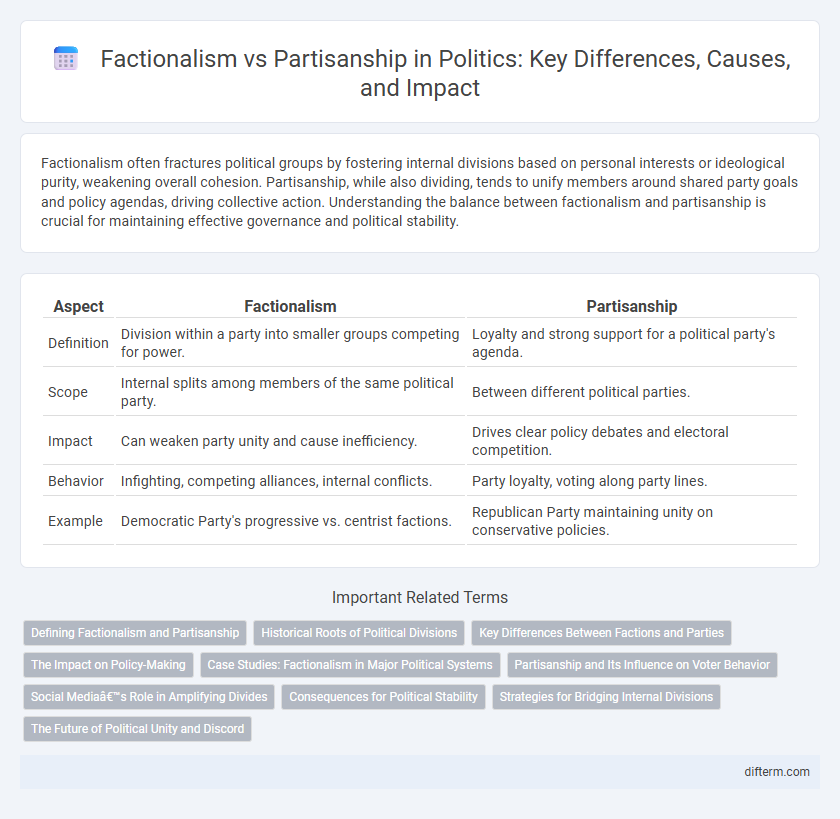Factionalism often fractures political groups by fostering internal divisions based on personal interests or ideological purity, weakening overall cohesion. Partisanship, while also dividing, tends to unify members around shared party goals and policy agendas, driving collective action. Understanding the balance between factionalism and partisanship is crucial for maintaining effective governance and political stability.
Table of Comparison
| Aspect | Factionalism | Partisanship |
|---|---|---|
| Definition | Division within a party into smaller groups competing for power. | Loyalty and strong support for a political party's agenda. |
| Scope | Internal splits among members of the same political party. | Between different political parties. |
| Impact | Can weaken party unity and cause inefficiency. | Drives clear policy debates and electoral competition. |
| Behavior | Infighting, competing alliances, internal conflicts. | Party loyalty, voting along party lines. |
| Example | Democratic Party's progressive vs. centrist factions. | Republican Party maintaining unity on conservative policies. |
Defining Factionalism and Partisanship
Factionalism refers to the emergence of organized sub-groups within a political party that prioritize internal power struggles and competing agendas over collective goals. Partisanship denotes a strong allegiance to a political party, emphasizing loyalty and consistent support for the party's platform and candidates. Distinguishing factionalism from partisanship is crucial for understanding internal party dynamics and their impact on political cohesion and legislative effectiveness.
Historical Roots of Political Divisions
The historical roots of political divisions trace back to early factionalism where competing elite groups vied for power, shaping foundational governance structures. Partisanship emerged later as organized political parties formed around shared ideologies and policy goals, reinforcing institutionalized loyalty. Key events such as the U.S. Federalist and Anti-Federalist debates illustrate the evolution from fluid factions to entrenched partisan alignments.
Key Differences Between Factions and Parties
Factions represent smaller, issue-specific groups within a larger political party that advocate for particular policies or ideological perspectives, while parties are broader organizations aiming to gain political power through electoral success. Factions often cause internal conflicts by promoting distinct agendas, whereas parties prioritize unity to maximize voter support and legislative influence. Understanding these dynamics clarifies how internal divisions influence overall party strategies and governance outcomes.
The Impact on Policy-Making
Factionalism often leads to fragmented policy agendas that hinder cohesive decision-making within political parties. Partisanship intensifies ideological divides, reducing bipartisan collaboration and slowing legislative progress. Both dynamics create obstacles to effective policy implementation by prioritizing internal power struggles or party loyalty over mutual compromise.
Case Studies: Factionalism in Major Political Systems
Factionalism within major political systems often leads to fragmented party cohesion and unpredictable policy outcomes, as seen in the Democratic Party's progressive and moderate wings in the United States, or the Conservative Party's Eurosceptic and pro-EU factions in the United Kingdom. These internal divisions contrast with partisanship, which aligns members strictly along party lines, resulting in more unified legislative agendas but heightened polarization. Case studies reveal that factionalism can prompt negotiation and compromise within parties, impacting electoral strategies and governance stability.
Partisanship and Its Influence on Voter Behavior
Partisanship significantly shapes voter behavior by creating strong emotional attachments to political parties, often leading individuals to support party candidates regardless of policy differences. This loyalty influences electoral outcomes, voter turnout, and policy preferences, reinforcing ideological divides within the electorate. Partisanship also affects information processing, as voters selectively expose themselves to news that confirms their party's stance, deepening polarization.
Social Media’s Role in Amplifying Divides
Social media platforms intensify factionalism by creating echo chambers that reinforce extreme viewpoints and polarize political discourse. Algorithms prioritize sensational and emotionally charged content, increasing partisan divide and reducing opportunities for constructive dialogue. This digital environment fosters identity-based politics, undermining bipartisan cooperation and deepening societal fractures.
Consequences for Political Stability
Factionalism often leads to fragmentation within political parties, undermining cohesive policymaking and weakening governance structures. Partisanship, while promoting party loyalty, can intensify polarization and obstruct bipartisan collaboration, stalling legislative progress. Both phenomena contribute to political instability by eroding public trust and diminishing the effectiveness of democratic institutions.
Strategies for Bridging Internal Divisions
Effective strategies for bridging internal divisions in political parties include fostering inclusive dialogue that prioritizes common goals over ideological differences, promoting transparent decision-making processes, and encouraging coalition-building across factions. Implementing conflict resolution mechanisms such as mediation and consensus-building workshops helps mitigate tensions and aligns diverse interests within the party. Emphasizing shared values and collective party identity strengthens unity and enhances overall electoral competitiveness.
The Future of Political Unity and Discord
Factionalism and partisanship shape the trajectory of political unity and discord by influencing cooperation within and across party lines. Factionalism often leads to internal divisions that weaken party cohesion, while partisanship reinforces loyalty but can exacerbate polarization between opposing groups. The future of political stability depends on balancing these dynamics to foster collaborative governance and mitigate entrenched conflicts.
factionalism vs partisanship Infographic

 difterm.com
difterm.com